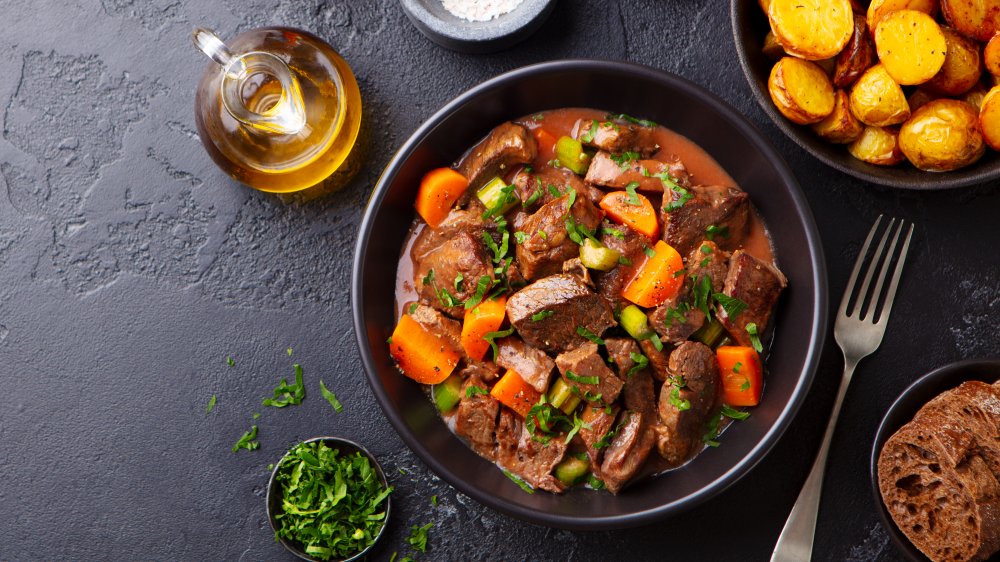Meat is a very important protein in the daily diet, responsible for providing the body with important benefits, as long as you consume it moderately. However, beyond its nutritional contributions, meat is the creator of exquisite culinary creations.
When you’re just starting out in the kitchen, one of the most common problems when cooking meat is achieving a smooth, juicy texture. Preparing roasts, stews or stews is relatively easy if you manage to overcome this important obstacle. For this reason, this time we bring you an easy guide to find out why stewed meat is hard, where you will discover all the secrets so that stewed meat is tender and exquisite.
Why is my stewed meat hard?
There are several reasons why stewed meat can be tough, and below we are going to mention the most common ones, but don’t worry, everything has a solution and that is why, if you continue reading, you will discover how to soften cooked tough meat:
- You have not chosen a good raw material.
- You have not chosen the correct cut or piece of meat.
- The meat is not in good condition.
- You have cut the piece incorrectly (against the grain).
- We have not used any technique to tenderize the meat before cooking it.
- You added salt at the beginning of cooking.
- You have not seared the meat well beforehand.
- You haven’t cooked the meat long enough.
- You have not let the preparation rest.
Things to keep in mind when buying meat
In the kitchen in general, choosing fresh and good quality products is crucial to obtain a good result. Of course, there are exceptions to the rule where the creativity of cooks and chefs is put to the test, but in general, the trick to obtaining juicy stewed meat begins with buying the raw material. Therefore, here are 3 very useful tips when choosing a good piece of meat:
- Select a good cut (part of the animal) as this is vital for tender meat. There are better pieces for some dishes and better ones for others. For example, to cook grilled, sautéed, battered, fried or roasted (large pieces); they are ideal cuts of sirloin, loin (chops), fillets and the upper part of the leg. If you plan to prepare braised, stewed and braised; the best pieces come from the animal’s skirt, chest, and lower leg. Remember, if the butcher is trustworthy, you can ask him if you have any questions.
- Choose a well cut piece. This point is crucial for any preparation and means that the piece must follow the classic cut and not against the natural fibers of the meat, depending on the part of the animal’s body to which it corresponds. Avoid accepting the last part i.e. the cut “against”. This type of cut is made in the most fibrous part of the animal; therefore, you will get a tough fillet.
- Notice the appearance of the meat. To know if a meat is fresh, you simply have to observe certain quite obvious details: good smell, natural reddish color (neither garish, nor ocher) and a creamy white fresh edge.
Tricks to make meat tender before cooking
Already at home in the kitchen, faced with the challenge of preparing juicy and tender meat, there is no shortage of tricks. There are many very useful facts to tenderize meat. Put on your apron and choose the one that best suits your preparation! The most common are:
- Pound, square or cut the meat into pieces.
- Marinate, macerate or marinate the pieces.
- Dip to soften in milk or yogurt.
- Add liquor, alcohol, baking soda or sugar.
- Bread, batter or wrap in fat.
- Seal, brown or pre-cook.
If you prefer to know in detail how to tenderize the meat before cooking it so that it is very sweet, go to our article on how to tenderize the meat where everything is explained point by point and step by step.
Things to keep in mind while cooking
The turning point! Yes, during cooking you know if the tricks you chose to make the stewed meat juicy worked or not. Why? Because during this step, little by little you discover what the final texture will look like. However, during this time you can still apply other strategies depending on the cooking you are going to use, thus ensuring a perfect result:
- Try to sear or brown the meat well before braising it. Since if you don’t, it will release the internal juices during cooking and thus it will be hard and lose all its sweetness.
- Avoid adding salt at the beginning of cooking. If you put salt at the beginning, you will dry the juices of the cut (by effect of osmosis) and the result will be a tough meat. Leave the salt for the end, during the last minutes of cooking or when serving the meat in a super tender sauce, like this recipe for pork in blackberry sauce.
- Add brandy or cognac (or other cooking alcohol)when cooking. When you cook the meat, add a splash of some liquor or alcohol that is normally used to give more flavors to the dish and it will surely soften it.
- Add a cork in the pot. A classic trick! Throwing in a cork while cooking meat is a very effective trick to tenderize it. This strategy is also applicable to shellfish such as octopus and squid.
- Remember to let the meat rest once it has finished cooking. It is important that it rest for at least 5 minutes after removing it from the heat so that it finishes absorbing all the flavors of the stew.
How to tenderize tough stew meat?
If you thought that after cooking tough meat, there is no going back, you are wrong. To tenderize already cooked stew meat, you just need to follow these easy steps:
- Separate from the stew, the hard pieces and the soft ones (or do not separate them if all the meat has been hard). Return the soft pieces to the stew and reserve. On the other hand, reserve the hard pieces.
- Pour very hot water into a saucepan. Enough water to cover the meat. Avoid cold water because it harms the softening process of the meat.
- Put the meat in the pan and pour a glass of cognac. A classic for tenderizing meat!
- Add baking soda. One teaspoon for every 350 grams of meat. An infallible softener!
- Place a cork inside the sauce pan. Another classic to soften meat, it never hurts to reinforce.
- Cook the meat for 15 or 20 minutes. The time can be extended or shortened, depending on the toughness of the meat, the portion of the meat, and the amount of baking soda you added. Remember not to exceed the cooking time because the meat can fall apart.
- Strain the meat. After the cooking time, remove the excess liquid.
- Let the pieces rest. Let the meat rest for at least 5 minutes.
- Add the meat to the reserved stew. It’s time to taste! Add the softened meat pieces to the reserved stew meat. Stir very well until both foods are incorporated and cook for 5 more minutes so that everything is well integrated.
You may be interested in trying this method with this recipe for beef stew in red wine.
Tip: Prime meats need fast cooking and inferior meats need slow cooking.
How to make stewed meat in a pressure cooker and make it soft?
Another great option for how to tenderize tough meat quickly and effectively is to cook it in a pressure cooker. Why is it more advantageous to cook meat in an express or pressure cooker? For several reasons:
- The heat is evenly distributed in the meat, that is, it cooks evenly.
- Cooking with less water preserves more nutrients.
- Prevents oxidation of food due to air, so they keep their colors.
- It eliminates any microorganism contained in the food, since cooking reaches a temperature above 100 degrees.
Tenderizing meat in the pressure cooker is very easy; you just need to follow a few very simple steps.
- Pour water into the pressure cooker, add the meat and close the lid.
- Cook the cut for approximately 15-30 minutes. A more precise cooking time depends on the type of meat. For example, a roast (beef, pork or lamb) is cooked between 15-25 minutes. While a stew (beef, pork or lamb) between 20-25 minutes and the stew is cooked between 30-35 minutes.
- Lower the heat, when the pan reaches its highest point of pressure.
- Turn off the heat and let sit for 20 minutes or until the pot stops steaming. Avoid opening the pan while it is still under pressure or cooling it under cold running water. Remember that the depressurization time also counts in cooking.
Things to keep in mind when serving
For you to finally taste a delicious meat in a super tender sauce or with another type of preparation, it is also important to know how to cut the meat when serving. Here are some tips:
- Let the meat rest. Wait a few minutes, so it will stay juicy. Resting time depends on the cut and size of the meat. Calculate 1 minute for every 100 grams of meat.
- Identify the direction to which the grains or muscle fibers of the meat are distributed.
- Position the knife blade at a favorable angle to the fibers and cut. It starts at one end and ends at the other.
Ready-to-cook?
If you were wondering how to make stewed beef tender and you didn’t know the answer to the question, why is stewed beef hard? you already have the solution. All you need is to combine several of the tricks recommended here and you will have guaranteed success. And… let’s cook!



